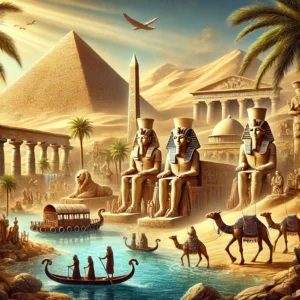 I came across a passage in 1 Chronicles recently that I never noticed before and it intrigued me enough to do a little research. 1 Chronicles 4:17 says, “The sons of Ezrah: Jether, Mered, Epher, and Jalon. These are the sons of Bithiah, daughter of Pharaoh, whom Mered married; and she conceived and bore Miriam, Shammai, and Ishbah father of Eshtemoa.” Maybe you noticed what I did. The daughter of Pharoah is listed in the genealogical charts of the Israelites. This means she left Egypt at some point and joined the Israelites! A deeper look at the genealogical chart shows that she married into the tribe of Judah, but her descendants do not appear to have played any major roles in Israelite history. The most intriguing part of this verse is that she is included in the genealogical list.
I came across a passage in 1 Chronicles recently that I never noticed before and it intrigued me enough to do a little research. 1 Chronicles 4:17 says, “The sons of Ezrah: Jether, Mered, Epher, and Jalon. These are the sons of Bithiah, daughter of Pharaoh, whom Mered married; and she conceived and bore Miriam, Shammai, and Ishbah father of Eshtemoa.” Maybe you noticed what I did. The daughter of Pharoah is listed in the genealogical charts of the Israelites. This means she left Egypt at some point and joined the Israelites! A deeper look at the genealogical chart shows that she married into the tribe of Judah, but her descendants do not appear to have played any major roles in Israelite history. The most intriguing part of this verse is that she is included in the genealogical list.
Most people do not think about the Exodus from Egypt including Egyptians. The assumption is that the Israelites packed up and moved out leaving the Egyptian people behind. But we have a few clues in different places of Scripture that add an intriguing element to this story. Seeing Bethia’s name in the Chronicles account is one piece of the puzzle. Another piece is the curious statement found in Exodus 12:38, “A mixed crowd also went up with them, and livestock in great numbers, both flocks and herds.”
Theologians have proposed the mixed crowd could have included other nationalities who were also enslaved in Egypt,[1] and a Midrash account claims some Egyptians celebrated Passover with the Israelites and joined them in their departure.[2] A historical account from Josephus points out that somewhere between 80,000 and 250,000 diseased or handicapped Egyptians were sent by Pharoah to live with the Israelites.[3] Each of these possibilities could account for the mixed crowd that left town.
Leviticus 24:10 mentions an Israelite mother and Egyptian father about a dispute between their son and someone else. The identification of the Egyptian father does not add to the story but does provide evidence for intermarrying among the Israelites. This marriage likely occurred prior to the Exodus since only a short amount of time passed between the Exodus and this event. The son would have also had to be of a sufficient age to be held accountable and put to death for his actions. These mixed marriages are another possibility for Egyptians leaving with the Israelites. One other account of a male Egyptian slave is mentioned in 1 Chronicles 2:34, so we have a clear indication that this mixed company included Egyptians. But Pharoah’s daughter? That part is more interesting. Some Jewish Rabbinical literature suggests that Bethia is the one who found Moses in the river, left the idol worship of her father behind, and joined with the Israelites.
It seems that when God chose to rescue his people, others saw the chance to escape with them, and as a result, they are now forever recorded in history.
[1] See M. Noth, Exodus: A Commentary (Philadelphia: Westminster Press, 1962), p. 99 and J. P. Hyatt, Commentary on Exodus (NCB; London: Oliphants, 1971), p. 1.
[2] Midrash Rabbah Exod. 18.10.
[3] Josephus, Against Apion, 1.234 and 1.290.